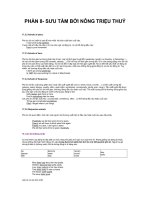Synthetic rubber by nikhil gupta
Bạn đang xem bản rút gọn của tài liệu. Xem và tải ngay bản đầy đủ của tài liệu tại đây (1.56 MB, 15 trang )
SYNTHETIC RUBBER
Synthetic Rubber
Styrene-Butadiene rubber (SBR)
Government rubber styrene (GR-S)
Buna-S
What is “Synthetic Rubber”?
A synthetic rubber is a material which can :
Undergo much more elastic deformation under stress
than most materials.
Return to its previous size without permanent
deformation.
STYRENE - BUTADIENE RUBBER
Styrene - Butadiene Rubber :
o
Styrene-butadiene or styrene-butadiene rubber (SBR)
describe families of styrene rubber derived from styrene
and butadiene.
o
Styrene – butadiene rubber (SBR) is made by using
75% butadiene and 25% styrene by weight . It is
a block co-polymer.PROPERTIES
PROPERTIES
•
Tensile strength of SBR can be increased to
250 kg/cm2
•
High resistance to heat & ageing.
•
High abrasion resistance.
•
High load bearing capacity
DISADVANTAGES
DISADVANTAGES:
•
Can be attacked easily by even traces of ozone if present in
air.
•
Can be spoiled by oils and solvents , due to swelling.
USES
Uses :
•
SBR is the most widely used rubber.
•
It is used in making tyre of vehicles/motors.
•
Other uses are , floor tiles , shoe soles , gaskets , footware
components , wire and cable insulation , carpet backing,
conveyer belts , etc.
NATURAL RUBBER
V/S
SYNTHETIC RUBBER
NATURAL RUBBER
V/S
SYNTHETIC RUBBER
NATURAL RUBBER VULCANISED RUBBER SYNTHETIC RUBBER
Low tensile strenght –
20kg/cm2
Higher tensile strength-
200kg/cm2
Much higher tensile strength-
250kg/cm2
Temperatur range –
10o c to 60 o c
Temperatur range –
40o c to 150 o c
Highly resistant to heat
High tackiness Low tackiness No tackiness
Poor abrasion High abrasion resistance Much more higher abrasion
resistence
Soft & Weak Stronger Strongest
THANK YOU!









